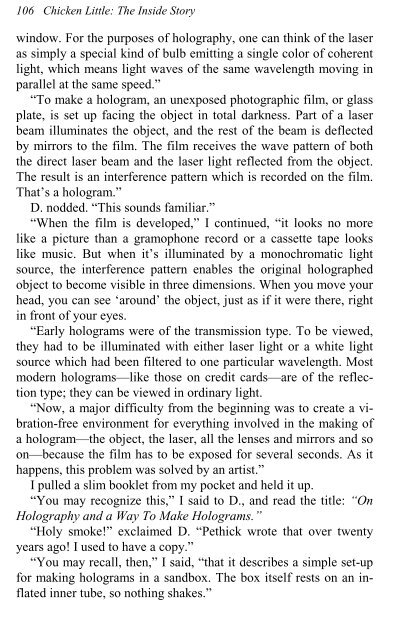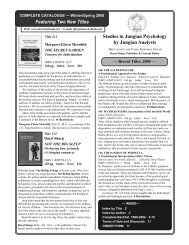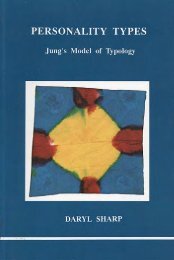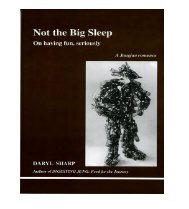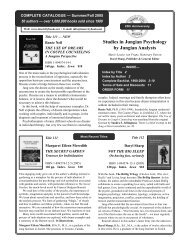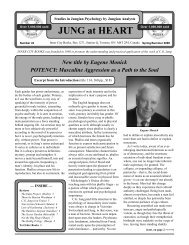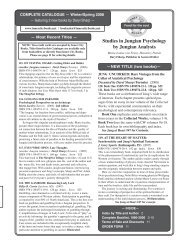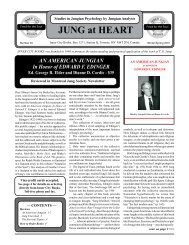Chicken Little: The Inside Story (A Jungian ... - Inner City Books
Chicken Little: The Inside Story (A Jungian ... - Inner City Books
Chicken Little: The Inside Story (A Jungian ... - Inner City Books
You also want an ePaper? Increase the reach of your titles
YUMPU automatically turns print PDFs into web optimized ePapers that Google loves.
106 <strong>Chicken</strong> <strong>Little</strong>: <strong>The</strong> <strong>Inside</strong> <strong>Story</strong><br />
window. For the purposes of holography, one can think of the laser<br />
as simply a special kind of bulb emitting a single color of coherent<br />
light, which means light waves of the same wavelength moving in<br />
parallel at the same speed.”<br />
“To make a hologram, an unexposed photographic film, or glass<br />
plate, is set up facing the object in total darkness. Part of a laser<br />
beam illuminates the object, and the rest of the beam is deflected<br />
by mirrors to the film. <strong>The</strong> film receives the wave pattern of both<br />
the direct laser beam and the laser light reflected from the object.<br />
<strong>The</strong> result is an interference pattern which is recorded on the film.<br />
That’s a hologram.”<br />
D. nodded. “This sounds familiar.”<br />
“When the film is developed,” I continued, “it looks no more<br />
like a picture than a gramophone record or a cassette tape looks<br />
like music. But when it’s illuminated by a monochromatic light<br />
source, the interference pattern enables the original holographed<br />
object to become visible in three dimensions. When you move your<br />
head, you can see ‘around’ the object, just as if it were there, right<br />
in front of your eyes.<br />
“Early holograms were of the transmission type. To be viewed,<br />
they had to be illuminated with either laser light or a white light<br />
source which had been filtered to one particular wavelength. Most<br />
modern holograms—like those on credit cards—are of the reflection<br />
type; they can be viewed in ordinary light.<br />
“Now, a major difficulty from the beginning was to create a vibration-free<br />
environment for everything involved in the making of<br />
a hologram—the object, the laser, all the lenses and mirrors and so<br />
on—because the film has to be exposed for several seconds. As it<br />
happens, this problem was solved by an artist.”<br />
I pulled a slim booklet from my pocket and held it up.<br />
“You may recognize this,” I said to D., and read the title: “On<br />
Holography and a Way To Make Holograms.”<br />
“Holy smoke!” exclaimed D. “Pethick wrote that over twenty<br />
years ago! I used to have a copy.”<br />
“You may recall, then,” I said, “that it describes a simple set-up<br />
for making holograms in a sandbox. <strong>The</strong> box itself rests on an inflated<br />
inner tube, so nothing shakes.”


